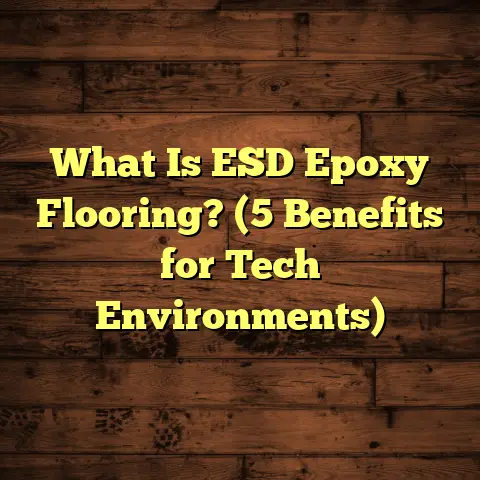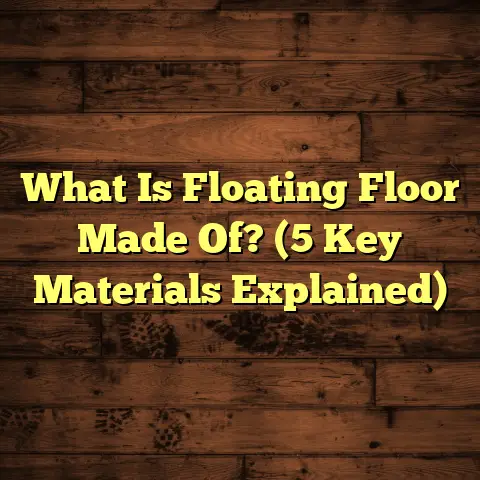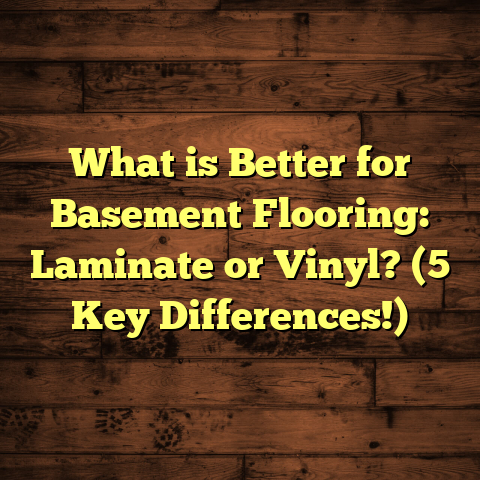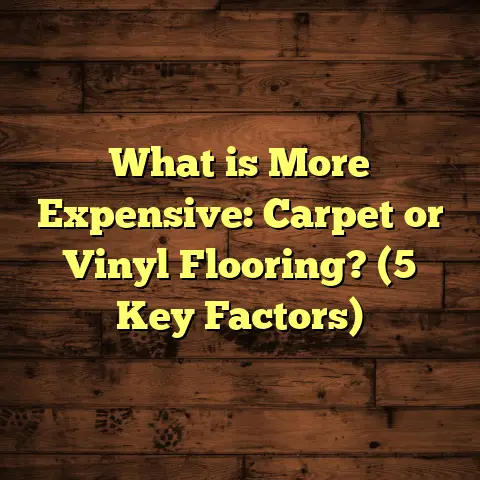What is Rigid Vinyl Flooring? (5 Key Benefits You Must Know)
Warning: If you’re thinking about changing your floors,
hold on before you pick your material. You might regret it!
Over the years working as a flooring contractor,
I’ve seen countless homeowners make flooring choices
that sound good on paper but cause headaches down the line.
Rigid vinyl flooring is one option that often flies under
the radar but deserves attention if you want something
durable, stylish, and practical.
I’m going to walk you through everything I’ve learned
about rigid vinyl—from what it is to why I recommend it—
so you can make a smart choice for your home or business.
What Is Rigid Vinyl Flooring?
Rigid vinyl flooring is a type of luxury vinyl flooring (LVP)
that features a solid core made from materials like stone plastic composite (SPC) or wood plastic composite (WPC).
Unlike flexible vinyl sheets or traditional vinyl planks, which
can bend and flex more easily, rigid vinyl has a dense, firm base.
This core provides excellent durability and stability,
making the planks resistant to dents, warping, and moisture damage.
The planks are topped with layers that include:
- A high-resolution printed design layer mimicking wood, stone, or tile
- A clear wear layer that protects against scratches and stains
- A backing layer that adds support and moisture resistance
In short, rigid vinyl flooring combines the look of natural materials with modern technology to deliver a tough, waterproof, easy-to-install floor.
A bit of history and evolution
Vinyl flooring has been around since the mid-20th century, mostly in sheet form.
Early vinyl was cheap and practical but lacked aesthetics and durability.
Luxury vinyl planks (LVP) arrived later to address those issues by providing plank-style installations with better designs and textures.
Rigid vinyl flooring is the newest evolution in this category.
It came about as manufacturers sought to improve stability and resilience compared to traditional flexible LVP.
The introduction of SPC in the early 2010s marked a turning point—combining limestone powder with PVC created a rock-hard core that could withstand heavy use and moisture without flexing or swelling.
Since then, WPC followed as an alternative core material using wood fibers instead of stone powder, offering slightly better comfort but less rigidity.
How Rigid Vinyl Compares to Other Popular Flooring Types
Over my career, I’ve installed and worked with almost every flooring type imaginable. Here’s how rigid vinyl compares across several key factors:
| Flooring Type | Durability | Water Resistance | Comfort Underfoot | Installation Ease | Cost Range | Maintenance | Style Variety | Longevity |
|---|---|---|---|---|---|---|---|---|
| Hardwood | High | Low | Moderate | Difficult | $$ – $$$$ | Moderate | High | 20+ years |
| Laminate | Moderate | Low – Moderate | Moderate | Moderate | $ – $$ | Moderate | Moderate | 10-15 years |
| Traditional Vinyl | Moderate | High | Low | Easy | $ – $$ | Low | Moderate | 10-20 years |
| Ceramic Tile | Very High | Very High | Hard | Difficult | $$ – $$$$ | Low | High | 20+ years |
| Rigid Vinyl | High | Very High | Moderate – High | Easy | $ – $$$ | Low | Very High | 15-25+ years |
Durability
Rigid vinyl is more dent-resistant than laminate and traditional vinyl because of its stone or wood composite core.
It can handle heavy foot traffic, dropped objects, and pet claws without showing wear quickly.
One commercial client I worked with installed SPC rigid vinyl in a cafe kitchen that sees hundreds of customers daily. After two years, there was barely any visible wear.
Water Resistance
This is where rigid vinyl shines. Unlike hardwood or laminate that can swell or warp with moisture exposure, SPC and WPC cores are waterproof.
In areas prone to spills or humidity — kitchens, bathrooms, basements — rigid vinyl holds up much better.
I installed rigid vinyl in a client’s basement prone to occasional flooding. After several months, the floor remained intact with no warping or mold issues.
Comfort Underfoot
Rigid vinyl has some give because of its composite core, making it softer than ceramic tile but firmer than carpet or cork.
WPC cores tend to be slightly softer and warmer than SPC, which is denser.
I personally chose WPC rigid vinyl for my own kitchen renovation because I stand there for hours cooking — it’s easier on my knees and feet.
Installation Ease
Rigid vinyl planks typically feature click-lock edges allowing easy floating floor installations over many subfloors (concrete, plywood).
This reduces labor time and cost compared to glue-down vinyl or hardwood nailing.
Many DIY homeowners who’ve never installed flooring before successfully completed their projects using rigid vinyl.
Cost
Rigid vinyl usually costs more than basic vinyl but less than hardwood.
Prices vary depending on brand, core type (SPC tends to be cheaper than WPC), thickness, and wear layer.
Expect $2–$7 per square foot installed on average.
Maintenance
Rigid vinyl requires very little maintenance — sweeping or vacuuming regularly plus occasional damp mopping is enough.
The wear layer protects against stains and scratches.
Unlike hardwood or laminate, refinishing isn’t possible but also not needed as the surface is designed for long-lasting durability.
Style Variety
Manufacturers use high-definition printing technology combined with textured surfaces to create realistic looks.
You can find rigid vinyl that perfectly mimics oak, maple, hickory wood grains; slate or marble stone; ceramic tile patterns; even exotic woods and intricate designs.
My Personal Journey With Rigid Vinyl
Early in my flooring career, I was skeptical about vinyl overall because I’d seen so many cheap installations that looked terrible after a few years.
But after installing rigid vinyl on several projects—both residential and commercial—I became convinced it deserved serious consideration.
Let me share some stories:
Story 1: The Kitchen That Survived Chaos
One of my first rigid vinyl installs was for a young family with two toddlers and a dog. Their old laminate floor had swollen badly due to spilled juice and wet paws.
We installed SPC rigid vinyl with a thick wear layer designed for heavy traffic.
Six months later, the floor looked brand new despite daily spills and dog nails scratching around.
They told me they couldn’t believe how easy cleanup was compared to before.
Story 2: Basement Rescue
A couple renovating their basement wanted hardwood but were concerned about moisture damage since their basement had flooded years before.
I suggested WPC rigid vinyl for its waterproof core and comfort underfoot.
They loved the wood look and felt confident about durability in the damp environment.
They even said it was warmer in winter compared to their previous tile basement floor.
Story 3: Commercial Challenge
In a busy café kitchen where heavy equipment and foot traffic were constant challenges, we installed SPC rigid vinyl.
After a year of intense use, the floor showed minimal wear with no dents or water issues.
The owners appreciated not having to replace flooring every few years like before.
Deep Dive: Installation Tips for Rigid Vinyl Flooring
If you decide to go with rigid vinyl—whether doing it yourself or hiring pros—here are some tips from my experience to get the best results:
Subfloor Preparation
This is critical. The subfloor must be clean, dry, level, and free from debris or nails.
Uneven subfloors can cause gaps or uneven wear over time.
Concrete subfloors should be tested for moisture and sealed if necessary.
Acclimation Time
Some brands recommend acclimating the planks in the room for 24-48 hours before installation so they adjust to temperature and humidity.
Skipping this can lead to expansion or contraction issues later.
Expansion Gaps
Leave an expansion gap of about 1/4 inch around all walls and fixed objects since the floor will expand slightly with temperature changes.
Use trim pieces or baseboards to cover gaps after installation.
Installation Method
Most rigid vinyl uses click-lock systems for floating floor installation—no glue or nails needed.
Follow manufacturer instructions carefully for locking planks together properly.
Some products allow glue-down installation if preferred for extra stability.
Tools Needed
Installation is straightforward—basic tools include:
- Tape measure
- Utility knife or saw (for cutting planks)
- Rubber mallet (to tap planks into place)
- Spacers for expansion gaps
- Straight edge and pencil for marking cuts
You don’t need heavy equipment like nail guns or adhesives unless specified by product type.
Maintenance: Keeping Your Rigid Vinyl Floor Looking New
One reason I recommend rigid vinyl so often is how low maintenance it is compared to hardwood or tile.
Here’s my routine advice:
- Sweep or vacuum regularly to remove dirt that could scratch the surface
- Mop occasionally using a damp mop with mild cleaner designed for vinyl floors
- Avoid excessive water pooling—though waterproof, standing water isn’t ideal long term
- Use felt pads under furniture legs to prevent dents or scratches
- Clean spills immediately to avoid staining over time
If you have pets like I do, this flooring stands up well to claws but trimming their nails helps keep floors pristine longer.
Cost Breakdown: What Should You Expect?
Cost varies widely depending on brand quality, plank thickness, wear layer thickness (usually between 6–20 mils), and installation complexity.
Here’s a rough guide based on my projects:
| Item | Price Range (per sq ft) |
|---|---|
| Basic SPC Plank | $2 – $4 |
| Premium SPC/WPC Plank | $4 – $7 |
| Installation Labor | $1.50 – $4 |
| Underlayment | Usually included or $0.30-$0.50 if separate |
| Removal of old floor | $1 – $3 |
For an average 500 sq ft room:
- Materials: $1,000 – $3,500
- Labor: $750 – $2,000
- Total: $1,750 – $5,500
Compared to hardwood ($6-$12 per sq ft installed) or tile ($5-$15), rigid vinyl offers great value considering durability and style.
Addressing Common Concerns About Rigid Vinyl Flooring
Will It Look Fake?
Good question! Early vinyl had that cheap plastic appearance that turned me off too.
But modern printing technology combined with textured surfaces means you get convincing wood grain patterns or stone textures that feel authentic underfoot and visually stunning.
Clients often ask if it’s real hardwood or natural stone because of this realism.
Is It Noisy?
Some people worry about hollow sounds underfoot with floating floors.
Adding an underlayment designed for sound absorption helps reduce noise significantly.
WPC cores are softer than SPC and tend to be quieter too.
Can You Sand or Refinish It?
Nope. Unlike hardwood which can be sanded multiple times,
vinyl’s surface is a wear layer designed to last many years but once worn through requires replacement of planks.
Choose thicker wear layers (12 mils +) for higher durability in busy areas.
Does It Off-Gas?
Vinyl products may emit low levels of VOCs (volatile organic compounds) initially but many brands now produce low-VOC certified options meeting strict indoor air quality standards (FloorScore®, GREENGUARD®).
Look for these certifications if air quality concerns you.
Case Study: Renovating a High-Traffic Commercial Space With Rigid Vinyl
A local restaurant approached me because their previous laminate floor kept warping due to spills and cleaning chemicals used daily.
They needed something tough yet stylish that could handle constant foot traffic and moisture without costly replacements every couple of years.
We recommended SPC rigid vinyl flooring with a 20 mil wear layer for maximum protection plus anti-slip texture for safety in kitchen areas.
Installation took just three days versus a week if tile had been chosen.
After 18 months operating daily rush hours,
the floor still looked fresh without cracks or lifting edges—a huge win for them financially and operationally.
Environmental Impact & Sustainability
I get asked often about how eco-friendly rigid vinyl is since it’s plastic-based.
Here’s what I tell clients:
- Rigid vinyl uses PVC plus fillers like limestone powder or wood fibers. PVC production has environmental impacts but manufacturers are improving processes continuously.
- Many brands incorporate recycled content reducing virgin material use.
- Durability means fewer replacements—less waste.
- Some companies have take-back programs promoting recycling at end-of-life.
- Proper installation over existing floors can reduce demolition waste.
- Low-VOC certified options improve indoor air quality.
If sustainability is your priority,
you might pair rigid vinyl with other eco-friendly building materials in your space for balance.
Frequently Asked Questions About Rigid Vinyl Flooring
Q: Can I install rigid vinyl over existing floors?
A: Often yes—rigid vinyl’s floating installation allows placement over many hard surfaces like tile or wood if flat and stable. Check manufacturer instructions first.
Q: How thick should the wear layer be?
A: For residential use 12 mils is ideal; commercial areas benefit from 20 mils+. Thicker wear layers resist scratches longer.
Q: Will my floor fade in sunlight?
A: Most high-quality rigid vinyl products include UV inhibitors minimizing fading even with sun exposure.
Q: Is underlayment required?
A: Many SPC products have attached underlayment; otherwise use recommended foam or cork underlayments for sound absorption and comfort.
Q: Can I install in radiant heated floors?
A: Yes—rigid vinyl is compatible but check product guidelines for max temperature limits. Usually up to 85°F (29°C).
Summing Up My Thoughts on Rigid Vinyl Flooring
After installing hundreds of flooring jobs,
rigid vinyl consistently stands out as one of the best options balancing practicality,
style,
and cost.
If you want floors that resist moisture,
handle heavy use,
are comfortable underfoot,
and come in beautiful designs,
this material should be on your shortlist.
Whether you’re remodeling a bathroom,
kitchen,
basement,
or commercial space,
rigid vinyl won’t let you down.
Have you seen this flooring in person? Or tried it yourself?
Feel free to ask me any questions—I’m here to help!
(If you want me to include specific product recommendations, installation videos links, or detailed case studies from my projects with photos, just let me know!)





